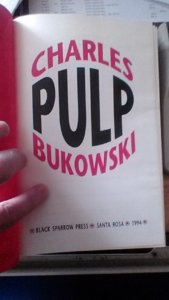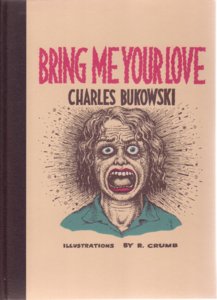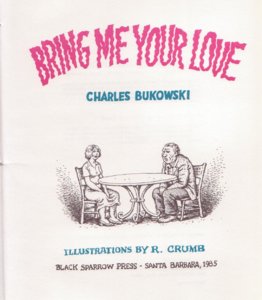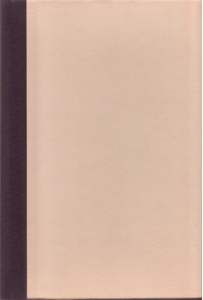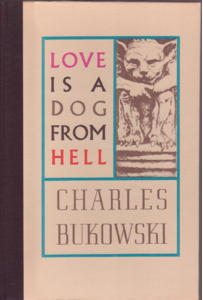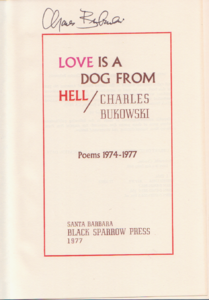You are using an out of date browser. It may not display this or other websites correctly.
You should upgrade or use an alternative browser.
You should upgrade or use an alternative browser.
Is this Pulp hardcover a first edition? (1 Viewer)
- Thread starter Beautown
- Start date
There are a very few known cases of BSP non-first printings having a color title page (I recall one case that was posted here several years ago). But yes, that sound be a first printing. Notice I say first printing, because that's really what's important here. Other than Women, I don't know of any Buk BSP title that has a second edition (meaning edits were made to the first edition). So, what's key is first edition, first printing. Technically, a 23rd printing of Post Office is still a first edition.
Pogue Mahone
Officials say drugs may have played a part
There are a very few known cases of BSP non-first printings having a color title page (I recall one case that was posted here several years ago).
I had a second edition Bring Me Your Love with a color title page. It also had a black cloth spine and labeled title on the spine.
I also had a Love is a Dog From Hell with a color page and a black (regular) spine. This one had a color page and there was nothing (other than the spine) to indicate it was not a first trade edition. That was a really weird one.
Was your Bring Me Your Love a second edition or a second printing? It might just be semantics.I had a second edition Bring Me Your Love with a color title page. It also had a black cloth spine and labeled title on the spine.
I also had a Love is a Dog From Hell with a color page and a black (regular) spine. This one had a color page and there was nothing (other than the spine) to indicate it was not a first trade edition. That was a really weird one.
Regarding Love is a Dog, I'm assuming it was a trade edition? The first trade came with black, red, and turquoise cloth spines. I'm not sure how you are concluding that the spine is telling you it's not a first.
Pogue Mahone
Officials say drugs may have played a part
OK, well Bring Me Your Love is clearly not a first because of the 1985 date, but Love is a Dog could well be a first. The missing spine label is perhaps a clue, or it just fell off. Do later printing hard covers have spine labels? I don't have any HC later printings. Also, do you remember what color the endpapers were? mine are that tourquoise-y color on the cover (Krumhansl calls it light blue).
bospress.net
www.bospress.net
later printing hardcovers DO have labels. I woudl say that Love is a Dog From Hell is a 1st/1st/
Pogue Mahone
Officials say drugs may have played a part
I wish I had scanned the whole Love is a Dog From Hell, but it was a signed book in perfect condition and I did not want to fuck with it too much. Krumhansl says the first edition had a "red corduroy cloth backstrip." That's clearly not the case with the photos I uploaded. I advertised the book as a later printing because of that.
I'll tell you though, everything seemed like a first. I remember looking at the page that lists the previous Bukowski books that Black Sparrow published and it didn't go past 1977 -- I believe Factotum was the last book listed.
Maybe we'll be able to answer this someday...
I'll tell you though, everything seemed like a first. I remember looking at the page that lists the previous Bukowski books that Black Sparrow published and it didn't go past 1977 -- I believe Factotum was the last book listed.
Maybe we'll be able to answer this someday...
Krumhansl lists the HC versions of LiaDFH as such:I wish I had scanned the whole Love is a Dog From Hell, but it was a signed book in perfect condition and I did not want to fuck with it too much. Krumhansl says the first edition had a "red corduroy cloth backstrip." That's clearly not the case with the photos I uploaded. I advertised the book as a later printing because of that.
First Trade: red corduroy cloth backstrip;
First Signed: light purple corduroy cloth backstrip
I know for almost certain (my source being an extremely reputable seller with the initials JM (not an editor)) that the first trade LiaDFH was also issued with a black cloth (not corduroy) and teal (light blue; perhaps corduroy, perhaps not) cloth binding. Not definitive, but Krumhansl couldn't possible see and document all variants.
Pogue Mahone
Officials say drugs may have played a part
JM (not an editor)
Well I would definitely defer to JM -- he's the Mas(t)er. (not that I'd easily discount your knowledge). Thank you.
As a matter of fact, after doing additional research, this may have been the exact book.
Last edited:
bospress.net
www.bospress.net
I have owned a teal and a black 1st. this oe has a lot of variants. Maybe it was Graham messing around with copies...
jordan
lothario speedwagon
in the immortal words of peter howard, regarding black sparrow: "there's no truth." meaning, there was no way to document anything definitively, since they constantly messed around with stuff like the spine cloth, color title pages, etc. i've seen all three variants of love is a dog, and i personally think that the red corduroy one looks best.
i had the same edition of 'bring me your love,' by the way. there was no trade hardcover printing originally, so that's technically a second printing, although it isn't dishonest to call it a 'first trade hardcover,' since that's what it is. it does have the color title page, which i would bet was an overprint from the first printing (if i had to guess). other "exceptions" include the 'first trade hardcover' 2nd printing of south of no north having a gray spine (not black) and the second, revised edition of women having a fancy corduroy spine instead of the normal black bookcloth or buckram that was sometimes used. i've also seen a third printing of collected stories by paul bowles with a turquoise spine.
i had the same edition of 'bring me your love,' by the way. there was no trade hardcover printing originally, so that's technically a second printing, although it isn't dishonest to call it a 'first trade hardcover,' since that's what it is. it does have the color title page, which i would bet was an overprint from the first printing (if i had to guess). other "exceptions" include the 'first trade hardcover' 2nd printing of south of no north having a gray spine (not black) and the second, revised edition of women having a fancy corduroy spine instead of the normal black bookcloth or buckram that was sometimes used. i've also seen a third printing of collected stories by paul bowles with a turquoise spine.
Pogue Mahone
Officials say drugs may have played a part
in the immortal words of peter howard, regarding black sparrow: "there's no truth." meaning, there was no way to document anything definitively, since they constantly messed around with stuff like the spine cloth, color title pages, etc. i've seen all three variants of love is a dog, and i personally think that the red corduroy one looks best.
That kind of pisses me off, and not because of the first trade book I sold -- I got a good enough price for it.
But if Black Sparrow wanted to create these "special edition" books as collectors' items, they should have been consistent in the way they produced them.
I've seen like 5 forgeries in the whole time I have been collecting Bukowski, all of which were drawings sold out of Europe.
Having said that, Black Sparrow (signed or otherwise) editions are supposed to be the safest purchase for someone who has never bought a Bukowski book -- usually for a friend as a gift. This makes it harder for them...
I know, people can always come here to verify and I should have really asked the forum myself when I was trying to figure out if it was a First. And if I ever have that situation again, I'll consult the forum next time.
On the plus side, I guess that messing with the spines, etc., means that some books are actually more uncommon, but...
Thanks for listening to me bitch... I learned a lot from this post, thank you!
jordan
lothario speedwagon
i hear what you're saying - consistency would definitely make collecting easier... but isn't it maybe more fun that there are these odds and ends strewn about? i think about it like going to see a band who puts on an amazing show even though they fuck up a few times vs. going to see rush, who plays the songs note-perfect to the point that it's like listening to the album really loud.
also, as the proprietor of a small press, i can say that no matter how much you try to make everything uniform, you never will. maybe you planned a certain run, but the cloth supplier was out of stock, so you switched halfway through. or you had more black corduroy than you thought, so one of the random later printings gets an unplanned fancy spine. shit like that happens all the time, and you roll with it. it makes black sparrow more "real" to me, in a way.
also, as the proprietor of a small press, i can say that no matter how much you try to make everything uniform, you never will. maybe you planned a certain run, but the cloth supplier was out of stock, so you switched halfway through. or you had more black corduroy than you thought, so one of the random later printings gets an unplanned fancy spine. shit like that happens all the time, and you roll with it. it makes black sparrow more "real" to me, in a way.
Great analogy. I remember seeing the Pretenders in '84 at the Worcester Centrum and wondering why I wasn't in my room with the LP cranked drinking a $0.50 beer. Part and parcel of why I like the Grateful Dead. Although post-'75 they didn't take as many chances, they let things ooze out as they happened. Sometimes it did work, sometimes it didn't, and sometimes when it did, it worked to perfection, despite being imperfect.i think about it like going to see a band who puts on an amazing show even though they fuck up a few times vs. going to see rush, who plays the songs note-perfect to the point that it's like listening to the album really loud.
Back to BSP; there are variants that buck the "rules," but on the whole, they were fairly consistent.
mjp
Founding member
I'm trying to remember if Black Sparrow ever came out and said definitively that these things (the color title page, the spine cloth colors) are part and parcel of a book being a first. I don't recall seeing any statement like that. It seems like the "rules" came about through observation and Krumhansl, not necessarily from Black Sparrow itself.
Hence my use of "air bunnies." :rolleyes:I don't recall seeing any statement like that. It seems like the "rules" came about through observation and Krumhansl, not necessarily from Black Sparrow itself.
Pogue Mahone
Officials say drugs may have played a part
It seems like the "rules" came about through observation and Krumhansl, not necessarily from Black Sparrow itself.
I get that. But Black Sparrow published the Krumhansl book, so it should have been "the definitive guide." In the few communications I've had with Martin, he seemed to be all over this kind of stuff.
By coincidence, last night I came across this letter from Bukowski to Martin from April 16, 1981. The entire letter is worth reading, but this portion seems appropriate for this thread...
...Your $250 bimonthly check which would break down to 6000 a year would probably make me eligible for food stamps. This doesn’t so much reflect my ability as a writer as it does Black Sparrow’s limited distribution. B.S. may print books as rare as diamonds and gain a literary reputation but not many people are buying diamonds these days, percentagewise…
(Thanks for the responses above -- I get it and you're right).
mjp
Founding member
I think the point Bukowski was making is that Martin wasn't shrewd enough. He's talking about the modern equivalent of $15k a year from Black Sparrow in 1981, which absolutely would have qualified him for food stamps. And also note that he was making the same amount from BSP three years earlier, in 1978.
The BSP money certainly wouldn't have bought him a house and new cars. Foreign royalties did that (in 1982 non BSP royalties were 15 times his take from BSP). It took another 10 years for the BSP money to get to that level.
Martin likes to talk about how much money Bukowski was making at the end of his life, but it's not unreasonable to wonder if Bukowski would have even made it to 1994 if he was living on BSP royalties alone. He would have still been in Hollywood, living in a cheap apartment.
I'm not trying to downplay the importance of BSP in Bukowski's life. I'm just balancing out the (many) people who overstate it. And I still maintain that had Martin not showed up, someone else - or some other publishing company - would have. It's a romantic story, Bukowski and Martin. But Martin/BSP alone wasn't enough to take him out of East Hollywood. Not until the last few years of his life, anyway.
And - I meant to stop a while ago, really, but - you could also reasonably argue that Bukowski's foreign fame went a long way toward making Black Sparrow what it eventually became. The Barfly movie really put him on the map as far as the general public goes, and Barfly wasn't made by an American. It wasn't sold by Martin.
This could go on indefinitely, these connecting threads and what, exactly, was responsible for what. The fact is everything was responsible for everything else, and it all boiled down to the man and his work. And that he continued to work, no matter what else was happening in his life.
The BSP money certainly wouldn't have bought him a house and new cars. Foreign royalties did that (in 1982 non BSP royalties were 15 times his take from BSP). It took another 10 years for the BSP money to get to that level.
Martin likes to talk about how much money Bukowski was making at the end of his life, but it's not unreasonable to wonder if Bukowski would have even made it to 1994 if he was living on BSP royalties alone. He would have still been in Hollywood, living in a cheap apartment.
I'm not trying to downplay the importance of BSP in Bukowski's life. I'm just balancing out the (many) people who overstate it. And I still maintain that had Martin not showed up, someone else - or some other publishing company - would have. It's a romantic story, Bukowski and Martin. But Martin/BSP alone wasn't enough to take him out of East Hollywood. Not until the last few years of his life, anyway.
And - I meant to stop a while ago, really, but - you could also reasonably argue that Bukowski's foreign fame went a long way toward making Black Sparrow what it eventually became. The Barfly movie really put him on the map as far as the general public goes, and Barfly wasn't made by an American. It wasn't sold by Martin.
This could go on indefinitely, these connecting threads and what, exactly, was responsible for what. The fact is everything was responsible for everything else, and it all boiled down to the man and his work. And that he continued to work, no matter what else was happening in his life.
This must be your kind of movie. :acb:communications I've had with Martin
Pogue Mahone
Officials say drugs may have played a part
But Martin/BSP alone wasn't enough to take him out of East Hollywood. Not until the last few years of his life, anyway
I should have quoted the entire letter because it is essentially what MJP is saying. For example, because Martin got 20 percent of foreign sales, he was making easy money off Bukowski's back for (ironically) mass produced paperbacks.
The letter is from Reach for the Sun.
jordan
lothario speedwagon
i misread the original letter date as 1961, thinking that martin improved business-wise in the years since then. 1981 is quite a bit later.
i was more thinking about how martin got chain bookstores to change their terms in order to do business with black sparrow - stuff like that.
i was more thinking about how martin got chain bookstores to change their terms in order to do business with black sparrow - stuff like that.
Similar threads
- Replies
- 0
- Views
- 1K
- Replies
- 5
- Views
- 4K
- Replies
- 23
- Views
- 3K
- Replies
- 2
- Views
- 1K
Users who are viewing this thread
Total: 2 (members: 0, guests: 2)

